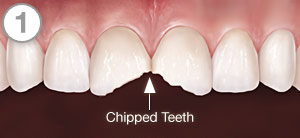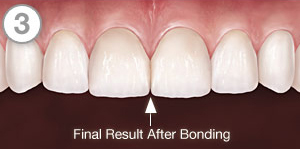Dental Bonding
Dental bonding is a procedure that uses resin composite (same as used in tooth colored fillings) to repair, reshape, resize or restore teeth. When skillfully applied, dental bonding can offer a wide range of cosmetic solutions such as:
- Repair chips and cracks
- Restore decayed teeth
- Treat slight imperfections
- Close spaces or make teeth wider
- Make teeth longer
- Change the shape of the teeth
- Change color or cover staining
- Cover exposed root and decrease sensitivity
- Full tooth coverage (Chair side composite veneers)
What is Dental Bonding? Bonding is a conservative approach to restore teeth (or change the way they look) that requires less preparation and tooth removal than traditional Veneers or Crowns. It offers our patients a solution that is quick, inexpensive and conservative. Without going into the science behind it, dental composite in conjunction with other materials bonds to your tooth on a molecular level. Most importantly, they come in a variety of shades that can be blended to give a natural, esthetic final result.
Preparation: Minimal preparation is usually required for bonding; in fact, anesthesia may not even be necessary. The tooth is prepared by roughening the surface for a better bond between the composite resin and the tooth. Following this, the tooth is etched and bonding liquid is applied. The tooth is now ready to be bonded. Using a shade guide to match colors, the composite material selected is artistically sculpted and smoothed to the desired shape matching the surrounding teeth, giving a natural appearance or finished to a new beautiful appearance depending on our desired outcome.



Why use bonding over veneers? Procedure time is one of the great benefits of bonding, you have the ability to leave with a new tooth that same appointment, requiring only one visit and no laboratory - the procedure takes about 30-60 minutes per tooth. Anesthesia may not be required (always a bonus when visiting the dentist). It is one of the least expensive cosmetic dental procedures that can have a huge impact on your smile. However, when compared to a porcelain restoration (veneer or crown) bonding does have reduced staining resistance and strength. Lastly, it is a conservative approach due to the nature of the material being able to physically bond to tooth structure very little tooth preparation is usually required.